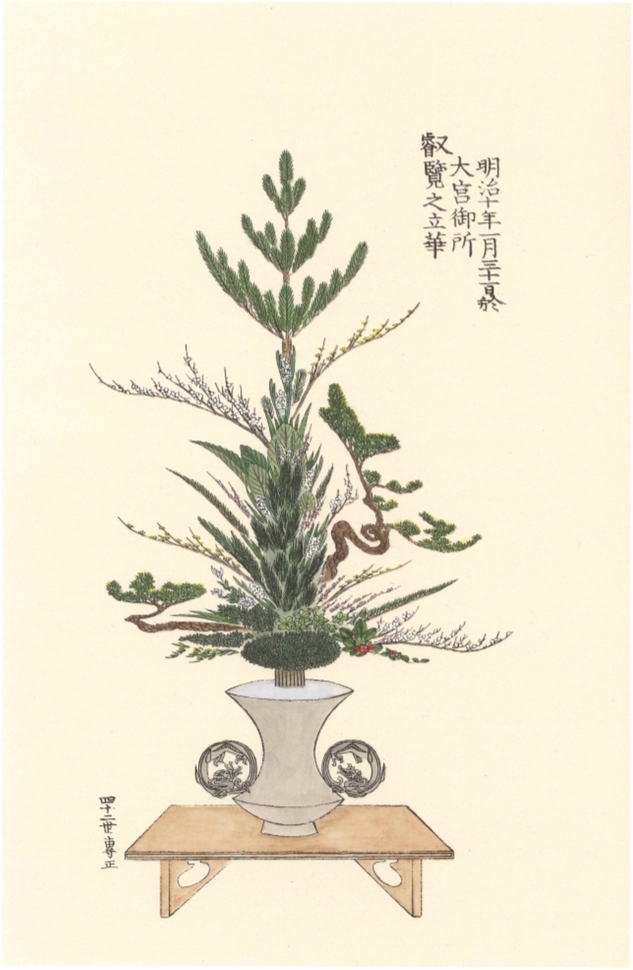Rikka on:
[Wikipedia]
[Google]
[Amazon]

 is a form of ''
is a form of ''
File:立花図并砂物 72.jpg, arrangement by Shūgyoku (from )
File:大住院立花砂物図 47.jpg, arrangement by Daijuin (from )
File:2017 Autumn Tanabata Exhibition Ikenobou doujou 11.jpg, arrangement

 is a form of ''
is a form of ''ikebana
is the Japanese art of flower arrangement. It is also known as . The tradition dates back to Heian period, when floral offerings were made at altars. Later, flower arrangements were instead used to adorn the (alcove) of a traditional Japan ...
''.
History
The origins go back to Buddhist offerings of flowers, which are placed upright in vases. This style was established in the Muromachi period (1333–1568). The term came to be a popular synonym for in the 15th century, when ''rikka'' became a distinctive element of interior decoration in the reception rooms at the residences of the military leaders, nobility, and priests of the time. It enjoyed a revival in the 17th century, and was used as a decorative technique for ceremonial and festive occasions. One of the proponents was Senkei Ikenobō . The essence of the direction of the rite was clarified by Sen'ō Ikenobō (, 1482–1543) in the manuscript . Today it is still practiced by the ''Ikenobō
is the oldest and largest school of ''ikebana'', the Japanese art of floral design.
It was founded in the 15th century by the Buddhist monk Senno. The school is based at the Rokkaku-dō temple in Kyoto. The name is derived from a pond (''ike' ...
'' school of flower arranging.
later developed into a less-formal style. It was eventually supplanted by the ''shōka
is a form of ''ikebana''. Written with the same ''kanji'' characters, it is also pronounced and known as ''Shōka''.
History
The painter Sōami and the art patron and ''shōgun'' Ashikaga Yoshimasa were supporters of the style as early as ...
'' style, which had a classical appearance but was asymmetrical in structure.
The '' Saga Go-ryū'' school has Buddhist roots and the style of floral offerings at the altar follows similar rules and is called .
Characteristics
The style reflects the magnificence of nature and its display. For example,pine
A pine is any conifer tree or shrub in the genus ''Pinus'' () of the family (biology), family Pinaceae. ''Pinus'' is the sole genus in the subfamily Pinoideae. The World Flora Online created by the Royal Botanic Gardens, Kew and Missouri Botanic ...
branches symbolize endurance and eternity, and yellow chrysanthemum
Chrysanthemums (), sometimes called mums or chrysanths, are flowering plants of the genus ''Chrysanthemum'' in the family Asteraceae. They are native to East Asia and northeastern Europe. Most species originate from East Asia and the cent ...
s symbolizes life. Trees can symbolise mountains, while grasses and flowers can suggest water. Until 1700, the arrangement consisted of seven main lines, and roughly starting in 1800, it consisted of nine main lines, each of which supports other minor lines. Important rules have been created that relate to the nature of the lines, their lengths and combinations of materials, the use of or (straw bundles), etc. Editing in that style can only be done through regular and long-term practice. The main axis, often the branch, is predominantly perpendicular, often the axis is formed by pine branches and is the most distinctive element of the arrangement. Both other lines are arranged at the bottom. The editing centre is filled like a bouquet of flowers.
''-''style arrangements were also used for festive events and exhibitions. They are usually quite large, from , and their construction requires the highest technical and artistic skills.
builds on the basics of traditional aesthetics of direction. It is used by seven or nine lines when creating a pattern. The arrangement is to be varied and expresses the diversity of nature, which is very characteristic for this direction.
was introduced in 1999. Its characteristics lie in the arrangement of lines that create nine to eleven branches or stems and the essence lies above all in balance, harmony, perspective and movement, although it follows the style. It is not important to follow the rule of only three plant materials. Exotic plant material is used as well as classical plants (salvia, pine).
Gallery
See also
*'' Moribana''References
External links
{{commons category-inline Ikebana